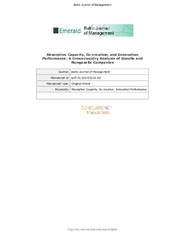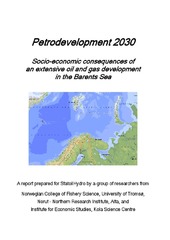Blar i forfatter Artikler, rapporter og annet (Handelshøgskolen) "Østbye, Stein"
-
Absorptive Capacity, Co-creation, and Innovation Performance: A Cross-country Analysis of Gazelle and Nongazelle Companies
Dahlin, Peter; Moilanen, Mikko; Østbye, Stein; Pesämaa, Ossi (Journal article; Tidsskriftartikkel; Peer reviewed, 2019-12-09)<i>Purpose</i> - The purpose of this paper is to examine the effect of absorptive capacity (ACAP) and co-creation on innovation performance (INN).<p> <p><i>Design/methodology/approach</i> - The authors use survey data from Swedish and Norwegian companies (<i>n</i>=1,102) and establish a cross-national equivalence between Sweden and Norway.<p> <p><i>Findings</i> - The subsequent structural ... -
The creative class: do jobs follow people or do people follow jobs?
Østbye, Stein; Moilanen, Mikko; Tervo, Hannu; Westerlund, Olle (Journal article; Tidsskriftartikkel; Peer reviewed, 2017-01-19)Regional adjustment models are applied to explore causal interaction between two types of people distinguished by educational attainment, and two types of jobs: creative class jobs and other jobs. Data used are for labour market regions in Finland, Norway and Sweden from the 2000s. Creative class jobs follow people with high educational attainment (one way causation), but creative class jobs also ... -
Doublespeak? Sustainability in the Arctic—A Text Mining Analysis of Norwegian Parliamentary Speeches
Moilanen, Mikko; Østbye, Stein (Journal article; Tidsskriftartikkel; Peer reviewed, 2021-08-21)This paper contributes to the recent literature on sustainability in the Arctic as a political concept. Parliamentary proceedings have increasingly been recognized as an important source of information for eliciting political issues. In this paper, we use unsupervised text mining techniques to analyze parliamentary speeches for Norway from the period from 2009 to 2016 to answer whether political ... -
Is migration important for regional convergence? Comparative evidence for Norwegian and Swedish counties, 1980-2000
Westerlund, Olle; Østbye, Stein (Working paper; Arbeidsnotat, 2006-06)Regional convergence studies have relied on net migration data in assessing the impact of migration. With heterogeneous labour, the implied symmetrical treatment of immigration and emigration cannot be justified a priori.. Because of heterogeneity among migrants, gross migration flows may lead to considerable interregional redistribution of human capital even when net migration is zero. Moreover, ... -
Kritisk viktig, men samfunnsøkonomisk ulønnsomt …
Bardal, Kjersti Granås; Solvoll, Gisle; Mathisen, Terje Andreas; Østbye, Stein (Journal article; Tidsskriftartikkel, 2021-04-19)<p>Samferdselsprosjekter som oppleves som kritisk viktige lokalt og regionalt, vurderes ofte som samfunnsøkonomisk ulønnsomme. Med mange prosjekter som konkurrerer om begrensede offentlige midler, er det da svært viktig at beslutninger om hvilke prosjekter som skal prioriteres er velbegrunnede og gjennomtenkte. <p>Den samfunnsøkonomiske analysen skal – ved å synliggjøre tiltakenes samfunnsøkonomiske ... -
Machine learning and the identification of Smart Specialisation thematic networks in Arctic Scandinavia
Moilanen, Mikko; Østbye, Stein; Jaakko, Simonen (Journal article; Tidsskriftartikkel; Peer reviewed, 2021-06-16)The European Union (EU) has recognized that universities and research institutes play a critical role in regional Smart Specialisation processes. Our research aims to identify thematic cross-border research domains across space and disciplines in Arctic Scandinavia. We identify potential domains using an unsupervised machine-learning technique (topic modelling). We uncover latent topics based on ... -
Management, markets and politics: Statistical screening for historical footprints in Arctic coal mining
Østbye, Stein; Sand, Jan Yngve; Westerlund, Olle (Journal article; Tidsskriftartikkel; Peer reviewed, 2011-11-29)The paper looks at the economic performance of the main (coal mining) company operating in Svalbard based on time series data from 1922 to 2006 and uses statistical techniques to detect structural breaks in economic indicators decomposed into components that the company control or influence and components that are exogenous. The analysis suggests distinctive historical periods and illustrates that ... -
Michael Polanyi on creativity
Festré, Agnès; Østbye, Stein (Journal article; Tidsskriftartikkel; Peer reviewed, 2021)We can know more than we can tell. In this paper we discuss how Polanyi applied his tacit knowledge concept to approach creativity. As a first step, Polanyi’s epistemological position is briefly discussed. Then his conceptualisation of tacit knowledge is presented, followed by a discussion of how Polanyi relates tacit knowledge to creativity in general and creativity in science in particular. We ... -
On rational forward-looking behavior in economic geography: An experimental analysis
Barreda-Tarrazona, Iván; Kundu, Tapas; Østbye, Stein (Journal article; Tidsskriftartikkel; Peer reviewed, 2021-02-05)This paper adapts the canonical New Economic Geography model for experimental testing of the model's behavioral assumptions by developing a finite-player, finite-horizon dynamic game of migration. Our analysis gives distinctive predictions when migration is consistent with myopic behavior (MB) and when it is consistent with sequentially rational or perfect forward-looking behavior (FB). These ... -
Petrodevelopment 2030: Socio-economic consequences of an extensive oil and gas development in the Barents Sea
Didyk, Vladimir; Arbo, Peter; Nilssen, Inge Berg; Hersoug, Bjørn; Nygaard, Vigdis; Sand, Jan Yngve; Østbye, Stein; Riabova, Larissa (Research report; Forskningsrapport, 2007-10)The theme of this report is the regional socio-economic consequences of an extensive oil and gas development in the Barents Sea. The regional focus area includes Finnmark County and Murmansk Oblast. The introductory chapter explains the purpose of the study and the way the work has been done. The next two chapters provide a detailed account of the region and its basic characteristics. The general ... -
Regional policy analysis in a simple NEG model with vertical linkages.
Østbye, Stein (Working paper; Arbeidsnotat, 2008-03)The paper presents a simple three-region, two-sector general equilibrium model that is used for analysing the effect of regional tax policies. The model includes exogenous asymmetry in terms of transport costs as well as a vertical industry structure that can account for endogenous location development in order to distinguish between the effect of ‘first nature’ and ‘second nature’ on the required ... -
Scraping the bottom of the barrel? Evidence on social mobility and internal migration from rural areas in nineteenth-century Norway
Moilanen, Mikko; Myhr, Sindre; Østbye, Stein (Journal article; Tidsskriftartikkel; Peer reviewed, 2021-05-11)We aim to answer whether expected occupational gains motivated rural-urban and rural-rural migration in nineteenth-century Norway. Human capital theory indicates that the higher expected gains, the more prone an individual will be to migrate. We use a micro-level data set of over 42,000 rural sons linked to their fathers based on 1865 and 1900 Norwegian censuses and employ a switching endogenous ... -
Should foreign producers oppose domestic state aid?
Østbye, Stein (Working paper; Arbeidsnotat, 2004-03)Can subsidies to domestic producers, de facto, be subsidies to foreign producers? If so, state aid may distort competition to the advantage of the foreign producers. At the same time, governments often oppose subsidies elsewhere, claiming that their industry is hurt. The possibility that governments fight subsidies on these grounds, although the effects are to the contrary, constitutes what is called ... -
The translog neoclassical growth model
Østbye, Stein (Working paper; Arbeidsnotat, 2004-03)The macroeconomic growth equation based on the translog aggregate production function is derived and compared to the growth equation based on Cobb-Douglas both with and without human capital. The model is estimated directly in structural form, using international panel data. Results are compared to the Cobb-Douglas case and a conventional fixed effect model.


 English
English norsk
norsk












